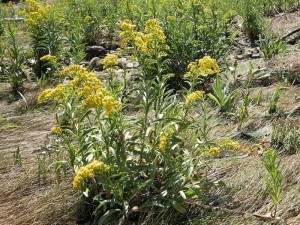Walks through the woods have certainly changed since early summer. Leaves are changing color and even falling. Squirrels are busily making nests and gathering nuts. But before you turn to picking apples and making pumpkin pie, there are a few summer pleasures still to enjoy.
The sites and smells are so different now than they were several weeks ago. Have you caught the wonderfully sweet smell of wild grapes ripening in the sun? What about the wildflowers? Goldenrods and aster – the composites rule right now. The Asteraceae or Compositae are a very large family of flowering plants including daisies, sunflowers, asters, goldenrods and pye weeds. The main feature of this plant family is the composite flowers. These flowers appear at first glance to be a single flower, but are actually made up of many flowers clustered together in an inflorescence (Think of a sunflower – each seed comes from a single flower; these flowers are clustered together into an inflorescence). A very informative website describes the different types of composite flowers: Backyard Nature.
This is a great time to get to know some of the common goldenrods and asters that dot the roadsides and trails. White woodland aster (Eurybia divaricata) is very common in woods and roadsides right now. This unassuming native flower is deer resistant, drought tolerant and long-blooming. Fields and openings are full of goldenrods including wrinkleleaf goldenrod (Solidago rugosa) and Canada goldenrod (Solidago canadensis). You can almost hear the hum from all the insects collecting pollen from the flowers. White goldenrod (Solidago bicolor) is the only goldenrod with white ray flowers found in the eastern United States, so it’s an easy one to recognize. Along the coast, you’ll easily spot seaside goldenrod (Solidago sempervirens) with its large fleshy leaves and bright yellow flowers. This goldenrod is found on beaches and dunes and is well adapted to salt spray.
The Connecticut Botanical Society has a website with excellent photos and descriptions of our native goldenrods and asters: CT Botanical Society. For those feeling more adventurous, Go Botany has easy to use identification keys that allow you to determine plant species based on simple morphological characters Go Botany. You can either go through the entire key from the beginning or use the shortcut to go directly to “Daisies, goldenrods or other aster family plants.”
So enjoy these crisp cool days of late summer and get to know the last flowers of the season.